Native American & Indigenous Arts & Culture covered by Artist Rye Purvis.
Don't wanna be here? Send us removal request.
Text
Your Hero is Not Untouchable Pt 2
Your Hero is Not Untouchable
A Monuments Study: Dakota War of 1862 Memorials, Monuments and Markers
by Rye Purvis 7/3/2020

(T.C. Cannon, Kiowa, painting “Andrew Myrick - Let Em Eat Grass” 1970)
On December 26th, 1862 38 Dakota prisoners of war were executed in Mankato, Minnesota. This was to mark an ending (though not an end to the suffering of the Dakota peoples) to the Dakota War of 1862, a war that began just months earlier in the Fall of ’62. The 38 men were ordered to be executed under the order of Abraham Lincoln, after Lincoln’s examined 303 war trials conducted from September to November of ’62 in Minnesota:
“The trials of the Dakota prisoners were deficient in many ways, even by military standards; and the officers who oversaw them did not conduct them according to military law. The hundreds of trials commenced on 28 September 1862 and were completed on 3 November; some lasted less than 5 minutes. No one explained the proceedings to the defendants, nor were the Sioux represented by defense attorneys. "The Dakota were tried, not in a state or federal criminal court, but before a military commission. They were convicted, not for the crime of murder, but for killings committed in warfare. The official review was conducted, not by an appellate court, but by the President of the United States. Many wars took place between Americans and members of the Indian nations, but in no others did the United States apply criminal sanctions to punish those defeated in war." The trials were also conducted in an atmosphere of extreme racist hostility towards the defendants expressed by the citizenry, the elected officials of the state of Minnesota and by the men conducting the trials themselves. "By November 3, the last day of the trials, the Commission had tried 392 Dakota, with as many as 42 tried in a single day." Not surprisingly, given the socially explosive conditions under which the trials took place, by the 10th of November the verdicts were in, and it was announced to the nation and the world that 303 Sioux prisoners had been convicted of murder and rape by the military commission and sentenced to death.” 1
Lincoln reviewed all transcripts from the rushed trials and made his decision on the final execution in under a month. The public execution remains the largest mass execution in American history. Today a public park remains at the site of the execution, named “Reconciliation Park” and given the theme “Forgive Everyone Everything.” 2 Merriam-Webster’s lists its dictionary definition of reconciliation as “the act of causing two people or groups to become friendly again after an argument or disagreement.”
It Starts with Treaties
To provide context to the Dakota War of 1862 is to acknowledge a trail of once again broken treaties and a US hunger for land acquisition. Before colonial interactions, the Great Sioux Nation covered present-day northern Minnesota and Wisconsin. The ancestors of the Sioux “arrived in the Northwoods of central Minnesota and northwestern Wisconsin from the Central Mississippi River shortly before 800 AD.” 3 Under the Great Sioux Nation are three subdivision groups: The Lakota (Northern Lakota, Central Lakota and Southern Lakota), Western Dakota (Yankton, Yanktonai) and the Eastern Dakota (Santee, Sisseton). It wasn’t until the early 1800’s that the Dakota, of the Sioux Nation, signed a treaty with the US in order to establish US Military posts in Minnesota and open trading for the Dakota. Soon after, the 1825 Treaty of Prarie du Chien and the 1830 Fourth Treaty of Prarie du Chien were put into place to cede more land to the American government. Another 1858 Treaty established the Yankton Sioux Reservation for the Yankton Western Dakota peoples, a treaty that ultimately moved the band from “eleven and a half million acres” to a “475,000 acre reservation.”11 The US created the Territory of Minnesota in 1849, thus placing even more pressure on the Sioux to concede land. More treaties followed with the 1851 Treaty of Mendota and the Treaty of Traverse des Sioux. In both deals, 21 million acres were ceded to the US by the Sisseton and Wahpeton bands of the Dakota in exchange for $1,665,000. “However, the American government kept more than 80% of the funds with only the interest (5% for 50 years) being paid to the Dakota” 4
The US’s aim ultimately was to force the Sioux out of Minnesota. Minnesota, established as a state on May 11, 1858 had two temporary reservations set up along the Minnesota River, one for the Upper Sioux Agency and one for the Lower Sioux Agency. Relocation and displacement from land once used for hunting created even more tension with delayed treaty payments causing economic suffering and starvation. Treaties promised payments to the Sioux, payments that were used for foods but at that point but were often late due to the US’s focus on the Civil War. Trader store operators many times charged credit to the Upper and Lower Sioux Agency’s, collecting the annuity allotments directly from the government in return.
Let them eat grass
Having owned stores in both the Upper and Lower Sioux Agency at the time, trader Andrew J Myrick eventually refused to sell food on credit to the Dakota during the summer of 1862. That summer saw additional hardship with failed crops in the previous year on top of late federal payments. In response to his refusal to allot food, Myrick was quoted as “allegedly” saying “Let them eat grass” a quote that is oftentimes disputed. Around the same time as this disputed quote, on August 17, 1862 a few Santee men of the Whapeton band killed a white farmer and part of his family, thus starting the beginning of the Dakota War of 1862.
This is where we in the 21st century have to take a pause. Most of the written accounts of the start of the war or the “murderous violence” of the “Murdering Indians” 5 (a quote from Peter G Beidler’s “Murdering Indians”) were accounts from the side of the colonizers. When researching the Dakota War of 1862, perspectives from the Dakota are not common. At some point the basis for war warrants a question of American mythology. In researching about this white farmer debacle, the killing is in one instance described as coming from “an argument between two young Santee men over the courage to steal eggs from a white farmer became a dare to kill.”6 In another account, the story follows the same narrative about the farmer’s eggs: “Upon seeing some chicken eggs in a nest at the farm of a white settler, there was a disagreement whether or not to take the eggs. When one refused, his companion dared him to prove that he was not afraid of the white man's reaction.”7 I bring up the eggs incident not to stress on this sliver of historical mythology but to emphasize the instability of perspective in historical accounts. Anti-Indian perspectives and a notion of eradication of the “Indian” has been profound in the beginning in the colonization of the US. For a war to rest on the stolen eggs of a farmer, and the killing of 5 individuals doesn’t take into account the broken down persons that were driven to get to the point of having to steal eggs nor what exactly occurred between the farmer and the men.
After the incident, however it occurred, Mdewakanton Dakota leader Little Crow led a group against the American settlements waging war as a means to remove the white settlers. Little Crow as he is known in European mistranslations, name was actually Thaóyate Dúta meaning “His Red Nation”. He was instrumental in leading discussions in the treaties, providing a voice for his people, and leading Dakota in the Battle of Birch Coulee. In a letter to Henry Sibley, the first Governor of the US State of Minnesota, on September 7, 1862, Thaóyate described the context for the uprising:
“Dear Sir – For what reason we have commenced this war I will tell you. it is on account of Maj. Galbrait [sic] we made a treaty with the Government a big for what little we do get and then cant get it till our children was dieing with hunger – it is with the traders that commence Mr A[ndrew] J Myrick told the Indians that they would eat grass or their own dung. Then Mr [William] Forbes told the lower Sioux that [they] were not men [,] then [Louis] Robert he was working with his friends how to defraud us of our money, if the young braves have push the white men I have done this myself." 8
Famine, broken treaties, late payments from the government were but a few of the motivating factors for driving change. The killing of the five white settlers by the 5 Santee men prompted a motion of action led by then natural leader Thaóyate.
When the war neared an end, Thaóyate and other Dakota warriors escaped. It wasn’t until July 3 of 1863 that Thaóyate was shot by 2 settlers and mortally wounded. Upon his death, Thaóyate’s body was mutilated and his remains were withheld from both family and his tribe until 1971 when the Minnesota Historical Society returned his remains to Thaóyate’s grandson. A historical marker remains where Thaóyate’s life was taken:
“[The] marker, erected in 1929 at the spot where Chief Little Crow (who escaped the hanging) was shot, glorifies the chief’s killer: “Chief Little Crow, leader of the Sioux Indian outbreak in 1862, was shot and killed about 330 feet from this point by Nathan Lamson and his son Chauncey July 3, 1863.” The marker does not mention that Little Crow’s body was mutilated, that his scalp was donated to the Minnesota Historical Society and put on display at the State Capitol. He would not be buried until 1971.” 9

Marker of where Little Crow was shot (photo by Sheila Regan)
I just want to acknowledge, that there is a lot of information to unpack that occurred during the Dakota War of 1862, and I don’t want to pretend that this article can sum up every occurrence, battle or person involved. Author and non-Native Gary Clayton Anderson wrote “Through Dakota Eyes” in 1988, and though not perfect, it provides eyewitness accounts from various Dakota peoples perspectives that is worth noting. The Minnesota Historical Society, though known for its problematic history holding on to Thaóyate’s body, also provides more information on its website regarding oral traditions, resources, publications and more in regards to the Dakota War of 1862. I encourage those interested in diving deeper into information to seek out more while simultaneously questioning the source of the information.
Stolen Bodies
Before Thaóyate’s death, the 38 Dakota men were hung at Mankato under Lincoln’s orders. An additional 2 men by the name of Shakpe and Wakanozanzan who had been captured were also executed on November 11th, 1865 under the order of Andrew Johnson. But this mass execution was not the end of the US’s threat to eradicate the Sioux. After the mass execution, “277 male members of the Sioux tribe, 16 women and two children and one member of the Ho-Chunk tribe”1 were sent to a prison camp at Camp McClellan from April 25, 1863 to April 10, 1866. The prisoners who did not survive Camp McClellan were buried in unmarked graves, later dug up and their skulls used by scientists at the Putnam Museum in the late 1870’s. The 23 skulls were given to the Dakota tribe and not until 2005 was a proper memorial ceremony held for the Dakota prisoners.
In addition, 1600 Dakota women, children and old men were forced into internment camps at Pike Island. Wita Tanka, the Dakota name for Pike Island, is now part of Fort Snelling State Park.
“During this time, more than 1600 Dakota women, children and old men were held in an internment camp on Pike Island, near Fort Snelling, Minnesota. Living conditions and sanitation were poor, and infectious disease struck the camp, killing more than three hundred.[37] In April 1863, the U.S. Congress abolished the reservation, declared all previous treaties with the Dakota null and void, and undertook proceedings to expel the Dakota people entirely from Minnesota. To this end, a bounty of $25 per scalp was placed on any Dakota found free within the boundaries of the state.[38] The only exception to this legislation applied to 208 Mdewakanton, who had remained neutral or assisted white settlers in the conflict."1
Where does this leave us?
The year was 1990 and a 36-year old Cheyenne and Arapaho artist by the name of Hock E Aye VI Edgar Heap of Birds had just finished an installation along the Mississippi River in Downtown Minneapolis titled “Building Minnesota.” The installation featured 40 white metal signs containing the names of the 38 men executed under the order of Abraham Lincoln, and the 2 men executed under the order of Andrew Johnson. Heap of Birds explained, “‘Not everyone loved the piece. Heap of Birds says that he received criticism because of the negative portrayal of Abraham Lincoln. ‘They thought it was a betrayal,’”9 Beyond that, the installation came to be known as a space for healing, mourning, for acknowledgement of the lost men, and a place for community to gather.

(One of the 38+2 Signs by Edgar Heap of Birds, photo from Met Museum)
Two monuments were placed up in 1987 and in 2012 at Reconciliation Park in Monkato, MN. The ‘87 monument named “Winter Warrior” features a Dakota warrior figure made by a local artist and the 2012 monument features a large scroll with poems, prayers, and the list of all the men killed on that dark day of 1862.
Beyond that, Minnesota boasts a plethora of statues, monuments and memorials under the umbrella of the Dakota War of 1862. Fort Ridgely State Park located near Fairfax MN hosts a number of monuments, Wood Lake State Monument, Camp Release State Monument, Defenders State Monument are a few of the myriad of locations dedicated to the Americans who fought, lost their lives as well as civilian causality acknowledgement.
Located in Morton, MN, the Birch Coulee monument was erected in 1894. Close to this monument a granite obelisk was erected five years later titled the “Loyal Indian Monument,” to honor the 6 Dakota “who saved the lives of whites during the U.S. Dakota War.” This monument stood out to me, not so much for its bland appearance, but the unusual circumstance to highlight six “loyal” Native lives amongst the many lost who were seen as disloyal.
Seth Eastman, a descendant of Little Thunder (one of the 38 men executed in Mankato) shared how “one public school at the border of Minnesota, where a man dressed as Abraham Lincoln talked to the students and answered their questions [and one] of my nephews asked the question, ‘Why did you hang the 38?’ This man went on to tell him, ‘Oh, I only hung the bad Indians. The ones that killed and raped.’ Telling kids this, that we’re bad, it’s the same as how we’ve been portrayed in the media. That struck my core.””
He continued:
“Minnesota has its own memorials for the Dakota War, but some of the older ones especially are quite problematic. These markers paint the settlers who fought the Dakota as brave victims who defended themselves, without discussion of the broken treaties and ill treatment the Dakota endured which prompted the war; neither is there any mention of the mass execution, internment, and forced removal that followed.”9
Director and Founder of Smooth Feather productions Silas Hagerty released the documentary Dakota 38 in 2012. The documentary highlights a yearly journey where riders from across the world meet in Lower Brule, South Dakota to take a 330-mile journey to Mankato as part of a commemoration and ceremony of remembrance for the 38 lost in 1862. The film also delves into bits of history on the attempts the US took to remove the Dakota peoples from Minnesota. Jim Miller, a direct descendant of Little Horse (one of the 38 men) started the annual ride in 2005 as “a way to promote reconciliation between American Indians and non-Native people. Other goals of the Memorial Ride include: provide healing from historical trauma; remember and honor the 38 + 2 who were hanged; bring awareness of Dakota history and to promote youth rides and healing.”10
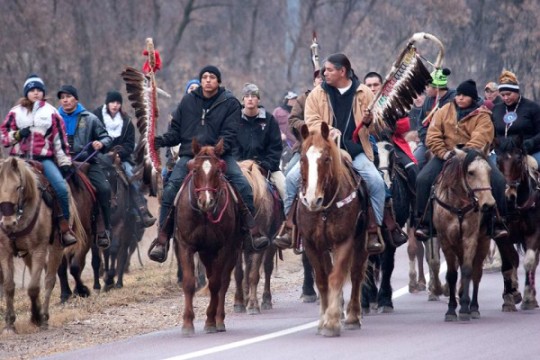
(Dakota Riders Ceremonial ride to Mankota, Photo by Sarah Penman)
The memorials and monuments are in abundance in regards to the Dakota War. But who’s perspective is acknowledged? Through work such as Edgar Heap of Birds in his 1990′s installation, to the 2012 larger public scroll monument in Mankato’s “Reconciliation Park” there have been steps taken by both Native and non-natives to explore what this reconciliation looks like.
Of the two Dakota men captured and ordered to be executed under then US president Andrew Johnson on November 11, 1865, Wakanozanzan of the Mdeqakanton Dakota Sioux Nation’s final words were:
“I am a common human being. Some day, the people will come from the heart and look at each other as common human beings. When they do that, come from the heart, this country will be a good place.”12
This article is dedicated to the 38+2.
-------
Images Sources Andrew Myrick – Let Em Eat Grass 1970 TC Cannon, Google Arts & Culture https://artsandculture.google.com/asset/andrew-myrick-let-em-eat-grass-t-c-cannon-kiowa-and-caddo-southern-plains-indian-museum/uwGyR0PTzacQkA
Met Museum photo of Edgar Heap of Birds artwork https://www.metmuseum.org/art/collection/search/653721
Mankota riders https://nativenewsonline.net/currents/dakota-382-wokiksuye-memorial-riders-commemorate-1862-hangings-ordered-lincoln/
Sources
1 https://en.wikipedia.org/wiki/Dakota_War_of_1862 2 https://www.mankatolife.com/attractions/reconciliation-park/ 3 Gibbon, Guy The Sioux: The Dakota and the Lakota Nations https://books.google.com/books/about/The_Sioux.html?id=s3gndFhmj9gC 4 https://en.wikipedia.org/wiki/Sioux 5 Beidler, Peter G. “Murdering Indians” October 17, 2013 https://books.google.com/books?id=4RRzAQAAQBAJ&dq=santee+men+murdered+white+farmer 6 History of the Santee Sioux Tribe in Nebraska http://www.santeedakota.org/santee_history_ii.htm 7 https://www.usdakotawar.org/history/acton-incident 8 Little Crow’s Letter https://www.usdakotawar.org/history/taoyateduta-little-crow 9 Regan, Sheila June 16, 2017 “In Minnesota, Listening to Native Perspective on Memorializing the Dakota War” Hyperallergic https://hyperallergic.com/385682/in-minnesota-listening-to-native-perspectives-on-memorializing-the-dakota-war/ 10 https://nativenewsonline.net/currents/dakota-382-wokiksuye-memorial-riders-commemorate-1862-hangings-ordered-lincoln/
11 https://en.wikipedia.org/wiki/Yankton_Sioux_Tribe
12 https://www.findagrave.com/memorial/64427183/wakan_ozanzan-medicine_bottle
Monuments Depicting Victims of the Dakota Uprising http://www.dakotavictims1862.com/monuments/index.html Morton, MN Monuments https://sites.google.com/site/mnvhlc/home/renville-county/morton-monuments
More information regarding Dakota War of 1862 Holocaust and Genocide Studies: Native American University of Minnesota https://cla.umn.edu/chgs/holocaust-genocide-education/resource-guides/native-american
2 notes
·
View notes
Text
Juneteenth & Additional BLM Resources Part 2

Juneteenth is tomorrow 6/19. In recognition and honor of this holiday, I am sharing some events going on in the Bay Area. As a Part Two to my earlier Black Lives Matter and Anti-Racist Resources post, I also have included organizations to check out and more resources listed towards the bottom of the article.
For those who do not know what Juneteenth is:
Juneteenth is the commemoration of the end of slavery in the United States, if you do not know about Juneteenth, I would recommend starting here: https://www.juneteenth.com/history.htm
As of today, it is NOT recognized as a national holiday. Someone has started a Petition online here to change that: https://www.change.org/p/united-states-congress-make-juneteenth-a-national-holiday-in-2020
Below are a few of the many events occurring this weekend in the Bay Area:
Juneteenth West Coast Port Shutdown!
Friday 6/19, 10AM-3PM Oscar Grant Plaza Guest Speaker Angela Davis

https://www.facebook.com/events/1568172636667783/
Juneteenth Reunion: A Rally Celebrating Black Queer Joy
Friday 6/19, 3-6PM 456 Castro St.

Event in Partnership with QBarSF and Strut
Juneteenth in the City
Friday 6/19, 2PM Dolores Park

Organized by the Bay Area Collective
Juneteenth Youth March & Rally Led by Black Teens in Oakland
Friday 6/19, 4PM DeFremery Park West Oakland
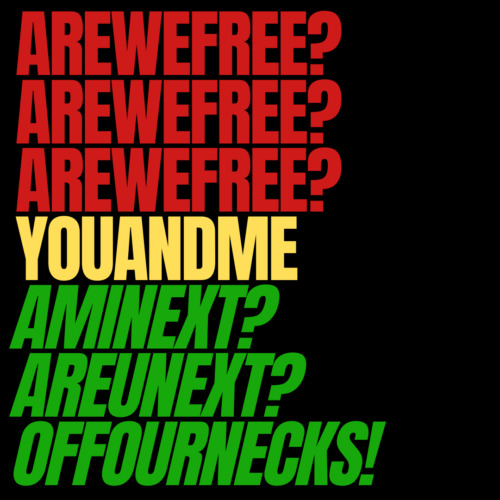
Organizers: Black Youth for the People's Liberation: https://www.by4pl.org/
Celebrate Black
Saturday 6/20 "Celebrate Black: Community Walk Celebrating the Value of Our Black Lies & The Beauty of our Culture"

Organizers: PKO, more info: https://www.instagram.com/pkoakland2020/
Juneteenth at the Lake
Friday 6/19, 1PM-Sunset Alameda Courthouse and March around Lake

Oraganizes: IG @wsmith16 @s.raihanna @yamsarchive
Black Women's Pride
Saturday 6/20, 6PM Oscar Grant Plaza


Organized by Black Queer Women and Femmes

There is a start of another list of Organizations in this post here: https://thenavajotourist.com/post/620043875327819776/black-lives-matter-bay-area-resources-support
Minnesota Freedom Fund https://minnesotafreedomfund.org/
The Innocent Project https://www.innocenceproject.org/
For the Gworls IG @forthegworls
The Transgender District transgenderdistrictsf.com IG @transgenderdistrict
National Bail Out https://nationalbailout.org/about/ IG @Nationalbailout
Black Aids Institute blackaids.org IG @blackaids
Black Trans Femmes in the Arts IG @btfacollective
Activation Residency IG @activationresidency
By Us for Us IG @bufu_byusforus
LGBTQ Freedom Fund www.lgbtqfund.org
Trans Justice Funding Project transjusticefundingproject.org IG @transjusticefp
Trans Women of Color Collective www.twocc.us IG @twoc_collective
The Okra Project theokraproject.com IG @theokraproject
Freedom Community Clinic https://www.freedomcommunityclinic.org/
CURYJ https://www.curyj.org/

NPR, List of Books, films and podcasts about Racism is a start
https://www.npr.org/sections/codeswitch/2020/06/06/871023438/this-list-of-books-films-and-podcasts-about-racism-is-a-start-not-a-panacea
New York Institute of Technlogy:
"Anti-Oppression LibGuide Anti-Racist Resources," https://libguides.nyit.edu/c.php?g=666045&p=4761364
Resources for Race, Equity, Anti-Racism and Inclusion, Includes Organizations and Black owned Bookstores,
https://diversebooks.org/resources-for-race-equity-and-inclusion/
Smithsonian "Being Antiracist" By Angela Y. Davis https://nmaahc.si.edu/learn/talking-about-race/topics/being-antiracist
Dazed "An essential list of books to help in becoming an anti-racist ally," https://www.dazeddigital.com/life-culture/article/49440/1/essential-reading-book-list-authors-black-anti-racist-protests
0 notes
Text
Your Hero is Not Untouchable Pt 1
Your Hero is Not Untouchable
A Monuments Study: Starting with Mt Rushmore
By Rye Purvis 6/17/2020
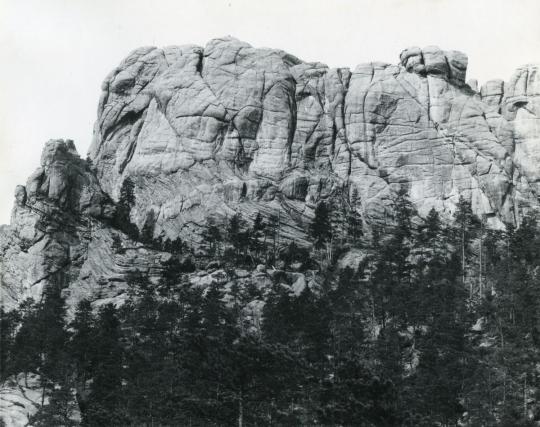
(Photo from Rapid City Journal Archives)
The Four Thieves
In 1868 the United States signed the “Treaty of Fort Laramie” with The Oglala, Miniconjou and Brulé Lakota, Yanktonai Dakota and the Arapaho Nations. The Treaty defined seventeen articles, namely defining territory to tribal members and protecting the land from white settler intervention. That all changed when white settlers moved onto tribal lands despite the Treaty when the allure of “gold” in the Black Hills led to expeditions by George Armstrong Custer in 1874. Territory largely remained on paper as “Indian Territory” until the Great Sioux War of 1876 where the United States government “unilaterally annexed native land protected under the treaty.” The treaty would be “modified three times by the US Congress between 1876 to 1889, each time taking more land originally granted, including unilaterally seizing the Black Hills in 1877.”1
Now under United States control, the Black Hills long known as a sacred ground for the Lakota people, were prepped to undergo a large carving in a 1927 federally funded project secured by then US Senator from South Dakota Peter Norbeck. Concurrently, according to the Meriam Report (a report on Indian “conditions” commissioned by the Rockefeller Foundation), the Sioux reservations in South Dakota saw largely starvation and dismal conditions. In James Fenelon’s “Culturicide, Resistance, and Survival of the Lakota Sioux Nation,” Fenelon writes that one man named Black Horse described such conditions: “we are starving…and eating our horses.” Another man, Fools Crow stated “the white population…was expanding; taking their land allotments, trading their ‘freedom for money and liquor’ with ‘no end to this curse.’”2 It had only been a mere 37 years prior that the United States Army massacred 250 Lakota men, women and children in the Wounded Knee Massacre. Food shortages were further heightened by years prior of European settlers hunting Bison (a staple for Lakota people) into near extinction. Cue Mt Rushmore:
“Sculptors were carving four faces of most famous Euro-American leaders, U.S. presidents, into a ‘great shrine of democracy and freedom’ on the monumental cliffs in the stolen Black Hills, in an area known to Lakota as ‘the six grandfathers.’ The Lakota dubbed the Mt. Rushmore result ‘the four thieves’ as each had engineered the taking of vast tracts of Indian land.”2
Did you know that Sioux Nation took the United States to Supreme court in a 1980 case to regain the Black Hills? The Supreme Court decided to instead give the “value of the land” in monetary value rather than the land itself. The Sioux has since declined the money (estimated to be over 1 Billion dollars, held within the Bureau of Indian Affairs) since this would “legally terminate Sioux demands for return of the Black Hills.”3 I know this fact isn’t related to monuments nor Mt Rushmore, but what is it is a testament to the resilience of the Sioux Nation despite years of war, famine, stolen land, broken treaties and the desecration of the Six Grandfathers.
Here’s another fact. According to the Smithsonian, Gutzon Borglum the creator/sculptor of Mt Rushmore was a white supremacist sympathizer who once said “I would not trust an Indian, off-hand, 9 out of 10, where I would not trust a white man 1 out of 10.” Borglum also worked alongside the Ku Klux Klan, becoming “involved in Klan politics.”4 Of course, this information doesn’t necessarily have to do with Mt Rushmore, but it makes for an interesting backdrop doesn’t it?
Lest We Forget
Art Historian’s Harriet Senie and Sally Webster remark in “Critical Issues in Public Art: Content, Context, and Controversy” the phenomenon of Mt Rushmore in displacing Sioux existence and history:
“It’s important to invent alternative pasts for a culture that finds it hard to accept the real one. It’s paradoxical that a Shrine of Democracy is placed in the center of land acquired through…the most blatant example of 500 years of genocide and hemispheric conquest. Rushmore implies that the European has always been here. It obscures a painful memory and eases racial guilt much the same way an individual represses thoughts that remind him of a painful experience.”5
This paradox permeates throughout American culture today, setting stage for the current climate of a demand for accountability and anti-racism manifesting throughout the US after George Floyd’s recorded murder by a Minneapolis Police Officer set off the motion of action. In just the last two weeks of June 2020, the world has watched as communities around the world have toppled over sculptures and monuments long considered representations of a colonized history. In fact, this past Monday, in my home state of New Mexico a protester was shot during a protest in Albuquerque in front of an Juan de Oñate statue. Oñate was a Spanish conquistador who was involved in the Acoma Massacre of 1599 that resulted in 500 Acoma men and 300 women and children killed as a result. This isn’t the first time protests have been held around such a figure. In 1998, a group of Acoma peoples cut off the foot of an Oñate statue in Alcalde, New Mexico as an act of defiance against the 400th year anniversary/celebration of Spanish “founding of New Mexico colony.” That’s not even the interesting part: “At the Oñate Monument and Visitors Center, Estevan Arellano, the director of the site, supervised the attachment of a new foot to the statue. He later said, ‘Give me a break – it was 400 years ago. It's okay to hold a grudge, but for 400 years?’”6
I digress.
Erin Genia wrote a great thesis titled “Wokiksuye: The Politics of Memory in Indigenous Art, Monuments and Public Space” and in it delves into the erasure of memory within a colonized landscape:
“Monuments play an important role in this process by supplanting Indigenous presence with shrines to colonization and occupation. A key pursuit of colonial empire-building is the forced erasure of memory. In this, colonizing powers have been so successful that people in the Western world are generally ignorant of their origins or their natural connections to the continuum of life. Knowing where you come from and what sustains you should be staples of consciousness for people of any culture. But the practice of eliminating memory and language has been taking place for so long that this fundamental knowledge is increasingly absent. The trajectory of world history has been dominated by those who have used their might to subjugate and take power from others to enrich a few chosen ones, using methods that wipe out the memory of the subjugated.”7
I wish I had the bandwidth to unpack the levels of effects colonization has had on BIPOC in America – all within a short online article on monuments- especially where Genia left us in the previous quote. The entire existence of the United States has been based on eliminating the memory and language of BIPOC through acts of genocide that pervade through monuments. So going back to Mr. Arellano’s quote “It’s okay to hold a grudge, but for 400 years?” No, toppling monuments in June 2020 are not acts of grudge or ill will, nor was it a grudge in 1998’s foot removal. Instead these are acts of recognition of painful histories that the US is grappling with, amongst a climate of people who have yet to fully acknowledge the atrocities of war, slavery, and genocide. In the words of the Acoma statement on the 1998 foot removal: “We see no glory in celebrating Oñate’s fourth centennial, and we do not want our faces rubbed in it.”
I will continue to write about other US Monuments in this series titled “Your Hero is Not Untouchable” including diving into contemporary artist responses.
Thank you for reading.
Quotes:
1 Treaty of Fort Laramie (1868) https://en.wikipedia.org/wiki/Treaty_of_Fort_Laramie_(1868)
2 Culturicide, Resistance, and Survival of the Lakota (Sioux Nation) James V. Fenelon
3 United States v Sioux Nation of Indianshttps://en.wikipedia.org/wiki/United_States_v._Sioux_Nation_of_Indians
4 Matthew Shaer, The Sordid History of Mount Rushmore, October 2016 https://www.smithsonianmag.com/history/sordid-history-mount-rushmore-180960446/
5 Harriet Senie, and Sally Webster, Critical Issues in Public Art: Content, Context, and Controversy. (Washington, DC: Smithsonian Institution Press, 1998), 249
6 Acoma Massacre
https://en.wikipedia.org/wiki/Acoma_Massacre
7 Genia, Erin, Wokiksuye: The Politics of Memory in Indigenous Art, Monuments and Public Space. Massachusetts Institute of Technology, 2019)
https://architecture.mit.edu/sites/architecture.mit.edu/files/user/attachments/Wokiksuye%20The%20Politics%20of%20Memory%20in%20Indigenous%20Art%20Monuments%20%26%20Public%20Space%20by%20Erin%20Genia.pdf
1 note
·
View note
Text
Black Lives Matter Bay Area Resources & Support
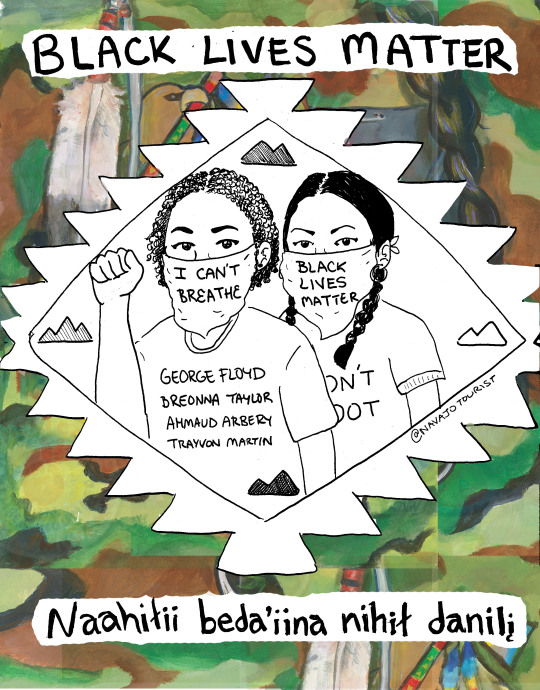
Hi All! It’s been a long time since i’ve posted, a lot has happened these several months. BUT what’s important and why I post today is share information for: Anti-Racist Resources, Black Owned Businesses YOU can support in the Bay Area, and Organizations Grassroots and bigger who are DOING the work. All links are below.
I’ll be compiling resources for New Mexico organizations/info in another entry.
SOLIDARITY NOT CHARITY
Shoutout to @dineaesthetics for their translation of Black Lives Matter to Diné. Indigenous Peoples for Black Lives, time to stand up, make some noise, educate ourselves and challenge systematic changes. NO TIME LIKE NOW.
Rye
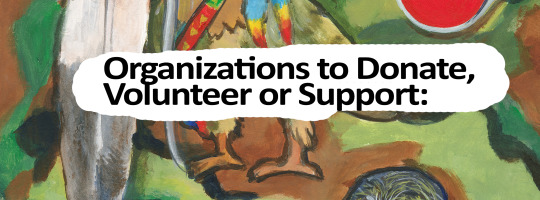
Black Visions Collective
“Black, trans, and queer led social justice organization and legal aid based in MN”
https://www.blackvisionsmn.org/
IG @blackvisionscollective
Campaign Zero
Nonprofit creating policy solutions to limit police interventions, improve community interaction and ensure accountability.
“Funds donated to Campaign Zero support the analysis of policing practices across the country, research to identify effective solutions to end police violence, technical assistance to organizers leading police accountability campaigns and the development of model legislation and advocacy to end police violence nationwide.”
https://www.joincampaignzero.org/
The Know Your Rights Camp
“Our mission is to advance the liberation and well-being of Black and Brown communities through education, self-empowerment, mass-mobilization and the creation of new systems that elevate the next generation of change leaders.”
https://www.knowyourrightscamp.com/
Reclaim The Block
“Organizes Minneapolis community and city council members to move money from the police department into other areas of the city’s budget that promote community health and safety”
https://www.reclaimtheblock.org/home
IG @reclaimtheblock
Anti Repression Committee
“Please call 415-909-4NNLG if you’ve been arrested or cited during recent demonstrations in the Bay Area and would like legal or bail support”
https://antirepressionbayarea.com/
IG @antirepression_bayarea
Anti Police-Terror Project
“The Anti Police-Terror Project is a Black-led, multi-racial, intergenerational coalition that seeks to build a replicable and sustainable model to eradicate police terror in communities of color. We support families surviving police terror in their fight for justice, documenting police abuses and connecting impacted families and community members with resources, legal referrals, and opportunities for healing. APTP began as a project of the ONYX Organizing Committee.”
https://www.antipoliceterrorproject.org/
IG @antipoliceterrorproject
Oakland Rising Action
“ORA is a community led political organization, engaging in voter education and GOTV operations that encourage Oakland’s working-class, immigrant, and communities of color to think critically about voting for or against issues. “
http://oaklandrisingaction.org/
IG @oaklandrisingaction
Black Organizing Project
“The Black Organizing Project is reviving the spirit of Oakland’s Black community through relationship building, leadership development, political education and policy change.”
http://blackorganizingproject.org/
https://www.facebook.com/BlackOrgProject/
IG @blackorganizingproject
People’s Breakfast Oakland
Raising bail for black people who have been arrested across Alameda county. Meals to houseless communities in Oakland
IG @peoplesbreakfastoakland
Black Earth Farms
“Grassroots Pan African & Pan Indigenous Farming Collective growing food in the East Bay”
IG @blackearthfarms
Color of Change
“We design campaigns powerful enough to end practices that unfairly hold Black people back, and champion solutions that move us all forward. Until justice is real.”
https://colorofchange.org/
IG @colorofchange
Showing Up for Racial Justice
“SURJ is a national network of groups and individuals working to undermine white supremacy and to work toward racial justice. Through community organizing, mobilizing, and education, SURJ moves white people to act as part of a multi-racial majority for justice with passion and accountability.”
https://www.showingupforracialjustice.org/
IG @showingupforracialjustice
TGI Justice Project
“Helps black trans leaders inside & outside of prisons through leadership development, legal support and re-entry programs.”
http://www.tgijp.org/
IG @tgijustice

Black Owned Restaurants in the Bay Area https://docs.google.com/spreadsheets/d/1mTthE5lwqVnTCIm3iQtQXLyxwK-pc17cuCp--BhAYX8/edit#gid=0
Restaurants in the Peninsula https://thesixfifty.com/all-of-us-can-do-something-local-black-restaurant-owners-react-to-george-floyd-protests-fdbe31acc400
Black Photographers Covering Protests and Hire Photographers https://docs.google.com/spreadsheets/u/1/d/1DMDZZGSq5YLqlskIf30yM2p8G944grtHR_0zKl6MAXY/htmlview?fbclid=IwAR1LzmfJ2d0hcVceYnCwZQcjmp5LxVg867qIy4siebVj2c8SkjpxwKEw_38
Black Owned Etsy Shops https://themadmommy.com/black-owned-etsy-shops/
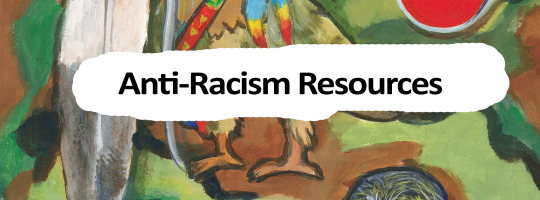
Protests, Initiative Donor List, Minority Businesses, Educate Yourself, Sign Petitions: https://www.adhoc.fm/post/black-lives-matter-resources-and-funds/
USA Today List of Anti Racist Books for Youth and Adults: https://www.usatoday.com/story/entertainment/books/2020/06/02/books-to-learn-more-anti-racism-adults-kids/5306873002/
Forbes Anti Racism Resource for White People https://www.forbes.com/sites/juliawuench/2020/06/02/first-listen-then-learn-anti-racism-resources-for-white-people/#5beb0d0d16ee
Understanding and Dismantling Racism Booklist for White Readers https://www.charisbooksandmore.com/understanding-and-dismantling-racism-booklist-white-readers
A Resource Guide For Anti-Racism + Being An Educated Ally For BIPOC http://theglitterguide.com/2020/05/30/resource-guide-for-anti-racism-being-an-educated-ally-for-poc/
Racial Justice Training for White Allies https://everydayfeminism.com/school/
10 Steps to Non-Optical Allyship by @mireillecharper https://www.vogue.co.uk/arts-and-lifestyle/article/non-optical-ally-guide
Guide to Allyship https://guidetoallyship.com/
Anti Racism Resource List https://docs.google.com/document/u/1/d/1BRlF2_zhNe86SGgHa6-VlBO-QgirITwCTugSfKie5Fs/mobilebasic?fbclid=IwAR3zVtsUtGvay2uPE6R294BFZ-O4ypqIRGXrrVmmM2Mcy4DZ4gg1G9M0rnQ&urp=gmail_link

Education for Liberation Network: https://www.youtube.com/channel/UCrPc74R46Sv7cTElnDn2TVg/live?fbclid=IwAR0gl8Nhwqi8H9U_0xTel7xLv6HKE6Spr_3yGf6wNAIDEZfOauZ9CIQv2YE
Raising Antiracist Kids: Ibram X. Kendi with Derecka Purnell https://www.eventbrite.com/checkout-external?eid=107620969216&ref=eios&fbclid=IwAR1RvL9HIiUki5CXL1mJpgI8_P9mY3f0aMlY7hebmdPtscG5dDGLvyitGTs
Anti Racism Webinars in June:
PR(iSM) RESISTANCE COALITION to host a two-part webinar series focused on strategies for engaging in racial equity conversations and actionable next steps:
https://www.resistheism.org/
Two Part Webinar:
White Folks (Part I): We Have to Talk About Race Jun 24, 2020 01:00 PM in Eastern Time (US and Canada) https://us02web.zoom.us/meeting/register/tZMrf-itrT4oG9ExXae-6B1PZSmeOnLZCBgC White Folks (Part II): A Call to Action Jul 22, 2020 01:00 PM in Eastern Time (US and Canada) https://us02web.zoom.us/meeting/register/tZUrdeuspz8oG9Lhlg1RtFV9T3D3YNcOr88w
National Resource List:
Document containing Community Bail Funds, Memorial Funds, political education tools, Advice/Tips for people attending protests or using social media as an organizing tool
https://docs.google.com/document/u/1/d/1CjZMORRVuv-I-qo4B0YfmOTqIOa3GUS207t5iuLZmyA/mobilebasic
0 notes
Text
Bay Area Artist Resources 3/27/20

Emergency Relief Funds, Grants and Resources:
San Francisco Arts Relief Fund San Francisco Arts Commission https://www.sfartscommission.org/content/san-francisco-arts-relief-fund https://www.cciarts.org/EmergencyRelief.htm
Safety Net Fund https://medium.com/@safetynet/the-safety-net-fund-20040273d291
National Coalition for Arts’ Preparedness & Emergency https://www.ncaper.org/
Foundation for Contemporary Arts Relief Funds Emergency Grants https://www.foundationforcontemporaryarts.org/grants/emergency-grants
Creative Capital Resource List https://creative-capital.org/2020/03/13/list-of-arts-resources-during-the-covid-19-outbreak/?goal=0_f4b146a631-53a2d59258-150494373&mc_cid=53a2d59258&mc_eid=7a117bf112
Untitled Art Emergency Fund Applications Due March 31st https://untitledart.s3.amazonaws.com/press/739c85/3c59132f8d.pdf
KQED’s List of Emergency Fund Resources https://www.kqed.org/arts/13876893/emergency-funds-for-freelancers-creatives-losing-income-during-coronavirus
________________________________________________________________
Artist Career Opportunities:
Teaching Artist Guild https://teachingartistsguild.org/jobs/
California Art Council http://www.arts.ca.gov/opportunities/jobs.php
Idealist https://www.idealist.org/en/?q=arts%20education&sort=relevance&type=JOB
Words of Mouth Resources for seeking remote work, starting with a growing list of interdisciplinary remote-friendly employers. Once a week newsletter http://www.wordsofmouth.org/
_____________________________________________________________
Resources for Teaching Artists:
Teaching Artists Guild Webinars, Podcasts, Labor Laws, Funding, Self Care, etc http://teachingartistsguild.org/covid-19-resources/
Online Arts Events, Exhibitions and Film Screenings https://creative-capital.org/2020/03/18/online-arts-events-during-the-covid-19-outbreak/
Art21 https://art21.org/
_______________________________________________________________
Arts and Advocacy:
California Alliance for Arts Education https://www.artsed411.org/
________________________________________________________________
Free Resources and Services:
Adobe Portfolio Free until May 31st https://portfolio.adobe.com/?trackingid=B8NR3Q11&mv=in-product
Free Software for Organizations https://www.zdnet.com/article/free-tools-and-services-for-businesses-during-the-covid-19-crisis/
Wifi, Higher-Ed, k12, Etc Resources https://www.salesforce.org/resources-for-education-institutions-navigating-covid-19/
Know anything else? Email [email protected] with suggestions, links, services.
0 notes
Text
Must Have Items This Holiday Season 2019

Not one to be captivated by the mythology that is Black Friday, I have always held a stance in defiance of the whole deal. But when it comes to small businesses and businesses owned and run by people I could get behind, the narrative shifts. “Small business Saturday” was first observed in 2010 through American Express in partnership with the National Trust for Historic Preservation. This new phenomena along with “Cyber Monday” give all the more reason and push to support homegrown businesses.
Which brings us to this list. Below are several businesses worth taking a look into this weekend. I’ve highlighted just a few of the many Indigenous and Native American owned brands out there, listing information about their businesses, websites, social media links, etc.
Enjoy and support these awesome homegrown brands, businesses and people!
Urban Native Era

About Urban Native Era: Founded by Joey Montoya in the Bay Area, the brand Urban Native Era is a fresh breath of air in its minimal design. Sweaters, hats, socks, accessories are all available on their website. Their mission states “Our vision is to empower these voices so we may reclaim our traditional knowledge and identity in this rapidly changing world; simultaneously redefining what it means to be Indigenous and Free.” Honestly it’ll be exciting to see where this brand will go and grow in the years to come.
Website: https://urbannativeera.com/ Facebook: https://www.facebook.com/UrbanNativeEra/ IG: https://www.instagram.com/urbannativeera
OXDX

About OXDX: “OXDX Clothing is a Native American owned business based out of Tempe, Arizona that specializes in graphic art, screen printed apparel, and cut'n'sew clothing. Owner, designer, and artist Jared Yazzie (Diné - Navajo) has been producing artwork since 2009 to increase awareness of indigenous issues and to show the beauty of Native culture.
‘OXDX’ is an abbreviation of the word "Overdose", a word Yazzie uses to describe the state of modern society. Sometimes we need to pull back and remember our culture, tradition, and those who have sacrificed before us. “ (from their Website)
Website: https://www.oxdxclothing.com/ Facebook: https://www.facebook.com/oxdxclothing/ IG: https://www.instagram.com/oxdxclothing
What to look for: Their Red Pattern pullover hoodies are definition of vibrant. The turquoise design popping off of the red sweater catches your eye instantly. According to their Instagam, there are only a “handful” printed and they go on sale Saturday at 12pm MST. Get at it.
EMME

About EMME: Most recently presenting her line of work at the Santa Fe Indian Market’s Haute Couture show, EMME founder Korina Emmerich runs her womenswear and accessory brand out of Brooklyn, New York. Her line reflects her “indigenous heritage stemming from the Coast Salish Territory, Puyallup tribe.”
Website: https://www.emmerichny.com/
What to look for: The “Angler Pull Over” is priced at a modest $69 and embodies both class and vigor in its color scheme. The “Medicine Wheel Maxi” is also a stunning piece, representing the four sacred colors in a floor length gown that is quite a statement piece for an evening out.
Salty Black Sheep Creations

About SaltyBSC: According to the business’s Etsy page, the creator of Salty Black Sheep is a Navajo graphic designer, using her skills to create cards, stickers, flyers and more that speak to the “souls and identities” of Native American people. What I find very cool about this business is that she is available for custom designs with clients. Many of her greeting cards are available to download to print yourself.
Etsy: https://www.etsy.com/shop/SaltyBlackSheep Facebook: https://www.facebook.com/SaltyBlackSheep/ IG: https://www.instagram.com/saltyblacksheepcreations
Reclaim Your Power

About Reclaim Your Power: A little bit of a mystery as I couldn’t find much besides the fact that Reclaim Your Power identifies being of the “Akwesasne Mohawk Territory.” Other than that, unsure about the creators of the brand.
Website: https://shop.spreadshirt.com/reclaimyourpower Facebook: https://www.facebook.com/reclaimourpower/ IG: https://www.instagram.com/reclaimyourpower
What to look for: Have you been to a pow wow or social function with fellow Indigenous and Native people in the last few months? Then you probably have seen Reclaim Your Power’s “Strong Resilient Indigenous” shirts. Simple, catchy, goes straight to the point. Basically a must have item.
Red Planet Books & Comics

About Red Planet Books & Comics: Opened in 2017, Red Planet Books & Comics prides itself on being the “only Native American comic shop in the world.” Their website boasts quite a collection of books, graphic novels and comics. Located in Albuquerque, they sell material online and in shop.
Website: https://redplanetbooksncomics.com/ Facebook: https://www.facebook.com/redplanetbooksabq/
What to look for: Available for preorder and coming out December 5th, “Ghost River: The Fall and Rise of the Conestoga” is a graphic novel about the massacre of the fourteen remaining Conestoga people of Pennsylvania. The ever talented Weshoyot Alvitre (Deer Woman: An Anthology, Sixkiller) illustrated this 60 page graphic novel. Included in the package comes a teacher lesson plan “developed by experts at the Gilder Lehrman Institute of American History.”
In the words of Red Planet Books, Ghost River “brings [the Conestoga Peoples] story to light; a story of despair and hope, loss and love, ancestors and the ghosts of history that are always with us.” If that doesn’t sound like a must read, I don’t know what else would.
Eighth Generation

About Eighth Generation: “Eighth Generation is a Native-owned and operated company based in Seattle, Washington. It was founded in 2008 when Louie Gong (Nooksack) — an artist, activist and educator widely known for merging traditional Coast Salish art with influences from his urban environment to make strong statements about identity — started customizing shoes in his living room. Now the first Native-owned company to ever produce wool blankets — with a flagship retail store in Seattle's iconic Pike Place Market — Eighth Generation is a proud participant in the global economy.” (from their Website)
Website: https://eighthgeneration.com/ Facebook: https://www.facebook.com/EighthGenerationbyLouieGong IG: https://www.instagram.com/eighth_generation/
A few other businesses worth checking out:
Birch Bark Coffee Company
Coffee Roaster and water rights advocacy in Canada
Website: https://birchbarkcoffeecompany.com
Trickster Company
Clothing, Jewelry, Sports equipment, etc
Website: https://trickstercompany.com/
Shy Natives
“Northern Cheyenne sisters making handmade lingerie
Website: https://www.facebook.com/shynatives/
Article on Vogue: https://www.vogue.com/vogueworld/article/shy-natives-indigenous-lingerie-jordan-madison-craig
Instagram: https://www.instagram.com/shynatives
Last but not least, support some local artists and businesses at these lovely events located in the Bay Area and New Mexico:
Indigenous Red Market Holiday Market

Where: Bay Area, Fruitvale Cedar Center, 3124 International Blvd, Oakland CA When: December 1st. 11AM-4PM Facebook Link: https://www.facebook.com/events/1448782845289058/
New Mexico School for the Arts Holiday Art Sale
Where: New Mexico School for the Arts, 500 Montezuma Ave, Santa Fe When: December 6th 5pm-7pm. December 7th 9am-12pm Facebook Link: https://www.facebook.com/events/352743035673910/
Signing Off , Rye Purvis “The Navajo Tourist”
#oxdxclothing#urbannativeera#redplanetbooks&comics#reclaimyourpower#saltyblacksheep#emme#indigenousredmarket#nativeamerican#nativeowned#indigenous#newmexicoschoolforthearts
0 notes
Text
American Indian Film Festival Recap Premiere Night 2019
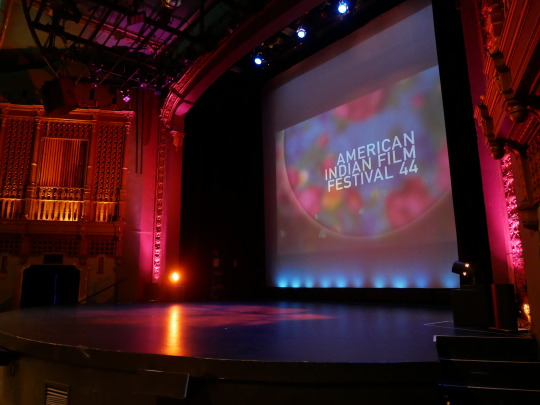
Published 11/2/2019, All Photos by Rye Purvis unless otherwise noted.
The American Indian Film Institute celebrated their 44th year of the American Indian Film Festival Saturday October 26th at the Brava Theatre in Mission District, San Francisco.
The Festival’s Emcee Tom Phillips (Kiowa) introduced the week long festival with an opening song by the All Nations Drum Group, performed in honor and remembrance of founder Michael Smith.

Tom Phillips (left) and All Nations Drum Group (right)
The night continued with a presentation of five films: Throat Singing in Kangirsuk, Sacheen: Breaking the Silence, Two Brothers, Henry’s Heart, and Red Snow.

Photo from Sundance Institute1
At a mere 4 minutes and 30 seconds, Throat Singing in Kangirsuk immediately takes viewers out of San Francisco and in to Kangirsuk, a small village where the directors and throat singers Eva Kaukai and Manon Chamberland are from. Drone shots by Johnny Nassak present birds eye views of both snowy and rocky horizons making for quite an ethereal landscape. Eva and Manon are seen fluctuating between a calm seriousness and a contagious playfulness, trying not to laugh while their voices reverberate meditatively. One can’t help but get entranced by the sound and image, almost wishing for more.
The second film of the night, Sacheen: Breaking the Silence had the honor of being introduced by Sacheen Littlefeather (Apache) herself, joined by producer Gayle Anne Kelley. The film directed by Peter Spirer, gave viewers a glimpse into the shocking moment at the 1973 Academy Awards when actress and activist Sacheen Littlefeather refused the best actor Oscar on behalf of Marlon Brando. The film gives a short but moving view of Sacheen’s perspective: who Sacheen is, what led up to the Oscar refusal, and what the aftermath looked like. Forty-five years after the fact, the televised moment remains astounding. Breaking the Silence gives voice and respect to the woman behind it all, the woman who carried the weight of the advocacy in the moment and decades after. Littlefeather’s voice is clear, direct and heard.

Sacheen (left) and Gayle (right) answering a question from the crowd during Q&A.
The third film of the night, Two Brothers directed by Montana Cypress (Miccosukee) was a 10 minute short film on the conversations and sense of unease two brothers experience as they prepare for the Seminole Wars. Montana Cypress also plays one of the brothers in the film.

Sacheen (far left), Gayle (second from left), Montana (on the mic) and Asivak
Henry’s Heart and Red Snow were the last films of the night. In Red Snow, actor Asivak Koostachin played Dylan, a Gwich’in soldier caught by the Taliban in this feature film directed by Marie Clements. The film is set in the present but intermittently shows flashbacks of Dylan’s life back in the Canadian Arctic where his relationship with his culture, Grandmother, and tragic young love influence the young man’s place in the world. Asivak does a wonderful job balancing the hardness of the soldier’s exterior with a complex impassioned interior as Dylan interacts with a Pashtun family through their escape from the Taliban.

Asivak (left) and Montana (right)

Crowd of Attendees in lobby of Brava Theatre
Overall, premiere night of the American Indian Film Festival gave a great array of film presentation, setting the tone for the week to come. From activism, to historical settings, personal conflicts and heartache, the films certainly reinstated the importance of Indigenous/Native/First Nation vision in media and entertainment.

Sacheen Littlefeather signing DVD covers.

Me and Sacheen (most exciting moment of the night tbh!)
Links to More Information on the Films:
Red Snow
Two Brothers
Sacheen: Breaking the Silence
Throat Singing in Kangirsuk
Henry’s Heart
Signing Off ,
Rye Purvis “The Navajo Tourist”
#sacheen littlefeather#montana cypress#aifi#american indian film festival#All Nations Drum Group#Sacheen: Breaking the Silence#Two Brothers#Red Snow#Marie Clements#Asivak#asivak koostachin#tom phillips
0 notes
Text
The Continuous Thread

Published 10/8/2019, All Photos by Rye Purvis unless otherwise noted.
The Continuous Thread: Celebrating Our Interwoven Histories, Identities, and Contributions opened Friday, October 4th at the SFAC Main Gallery located in the War Memorial Veteran’s Building of San Francisco. The exhibit curated by Carolyn Melenani Kurali’l (Native Hawaiian/Apache) features photography by Hulleah Tsinhnahjinnie (Taskigi/Diné), Britt Bradley (Algonquin/Hispanic/Irish) and Jean Melesaine (Samoan). Community representation against a backdrop of the reclaimed space where a discriminatory monument once stood make for an exhibit’s emphasis on the American Indian Urban Experience.
Photographs of over 150 Indigenous community members line the wall front and center as you walk into the SFAC’s Main Gallery. Warm portraits against black backgrounds take up five rows of portraits plentiful portraying Indigenous and Native youth, adult and elder alike. The photographs, taken by Jean Melesaine, a local documentary photographer, are both soft and stark. Located next to the photos a two-page list states every person’s name and tribal affiliation: A name to each portrait in recognition.

Melesaine’s line of portraits, 2019.
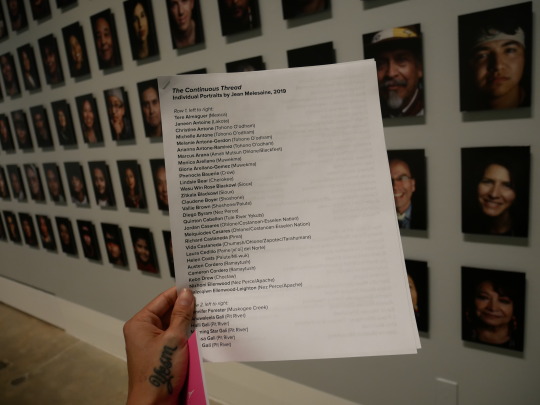
Individual Portraits list of names, 2019.
Recognition and reclamation reverberate through the exhibit walls, as the photography work focus on portraits taken in response to the removal of San Francisco Civic Center’s “Early Days” statue.
Early Days, a bronze statue located between SFPL and the Asian Art Museum, featured a Plains Native American man in a defenseless position on the ground as a missionary and vaquero towered over him. After nearly two and a half decades of protests and appeals, the 124-year-old statue Early Days was removed in September 2018. In April 2019, Melesaine alongside Tsinhnahjinnie and Bradley photographed the community in response to both the removal of Early Days and a celebration of the Indigenous community of the Bay Area thriving here and now.

(Left) Phoenix Lara, Photograph by Jean Melesaine. (Right) Bay Area American Indian Two-Spirits (BAAITS) Photograph by Hulleah Tsinhnahjinnie, 2019.
Hulleah Tsinhnahjinnie’s large scale group portraits powerfully showcase community members sitting and standing on the Early Days vacant monument plinth. The colorful portraits combine individuals together in what feels like a superhero aesthetic for the Native community. Titles such as “Strong-Hearted Women,” “Emerging Leaders: American Indian Youth,” “American Indian Scholars” and “Traditional Dance – The Art of Maintaining Strong and Vibrant Indigenous Communities” give sightline to Tsinhnahjinnie’s calculated collective of individuals. Next to an arrangement of 8 rectangular color photographs titled “Our Interwoven Histories, Identities and Contributions” a five-page document lists the individuals and their bios in a who’s who of the Native community. Recognition of each person’s achievements, interests and endeavors permeate from not only the portraits but the words as well.

Our Interwoven Histories, Identities and Contributions, Hulleah Tsinhnahjinnie, 2019.

Strong-Hearted Women, Hulleah Tsinhnahjinnie, 2019.
Britt Bradley’s black and white photography remain both memorizing and unapologetic. In a large-scale photograph titled “Practitioners of the Arts” five artists stare directly to the viewer, each artist representing various artistic backgrounds and mediums. One can’t help thinking of this portrait existing from decades ago as the photograph process exudes a timelessness. Bradley’s prints are made from a collodion wet plate process, a photographic technique created in the mid 1800’s. From Bradley’s website, Bradley explains “Much of collodion practician, both modern and historical, is a perpetual representation of the white male gaze. A perspective that has not truly shifted since the medium’s conception over 150 years ago. I am interested in how a medium that has continually been used to exploit marginalized voices, could instead be adapted to empower.” (1)
Bradley’s wet plate technique indeed takes nod to a time that also produced the Early Days statue of 1894. Using collodion process, the portraits take the viewer to an alternate version of the early days of San Francisco, presenting individuals empowered in their recognition and in their individual stories of monumental proportion.

Practitioners of the Arts, Britt Bradley, 2019.
Activists, Artists, Entrepreneurs, Students, Elders, People are presented in front of the viewer. The exhibition pushes past oftentimes what Museums and Fine Art Institutions displayed in the past: photographs of Indigenous and Native American community members without names, without stories, and without recognition. The displaying of each individual snippet of the participant’s background breaks past this practice, giving full recognition and an appreciation for the individual in one of the most empowering exhibits I’ve witnessed featuring Native and Indigenous artists of the Bay Area.

SFAC Director, Community Investments Barbara Mumby-Huerta speaks to a crowded room during the opening reception Friday, October 4th.
The artwork in Continuous Thread wasn’t the only highlight of the exhibition, the catering by Wahpepah’s Kitchen had a consistent presence of people surrounding their food for the entire reception on October 4th. Wahpepah Kitchen is run by Chef Crystal Wahpepa, a Chef recently featured on Food Network’s Chopped tv show. The Acorn squash with maple dish made for a vibrant and delicious display, amongst other dishes based on Wahpepa’s Kickapoo heritage. It is a wonder that there is not a restaurant location for such cuisine given the popularity at the reception (maybe soon? hopefully!).

Wahpepa Kitchen food display at the opening reception Friday October 4th.
Outside of the SFAC’s Main Gallery in the Café Valor, the exhibit “Wounds Many: Portraits of the Northern Ute” showcases work by Keith Secola. Up and coming Artist Keith Secola (Mino Mashkiki Wish Kang. Ute Indian Tribe/Bois Forte Chippewa) fresh off a Fellowship at the Kala Art Institute premiered screenprints highlighting members of the Northern Ute community. Secola’s silkscreen works vibrate off the walls with their engaging layers of the printed image on top of deconstructed American history books.
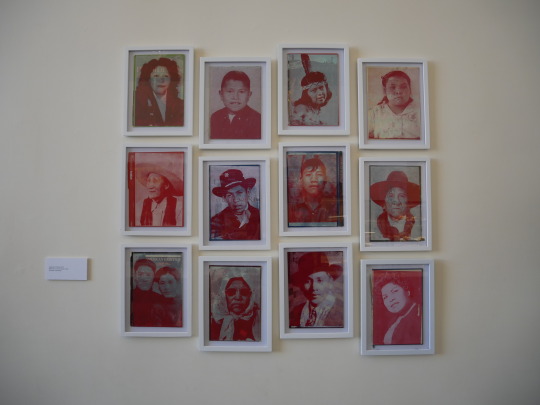
Cesspooch Family, Keith Secola, 2019. Silkscreen on found book covers.
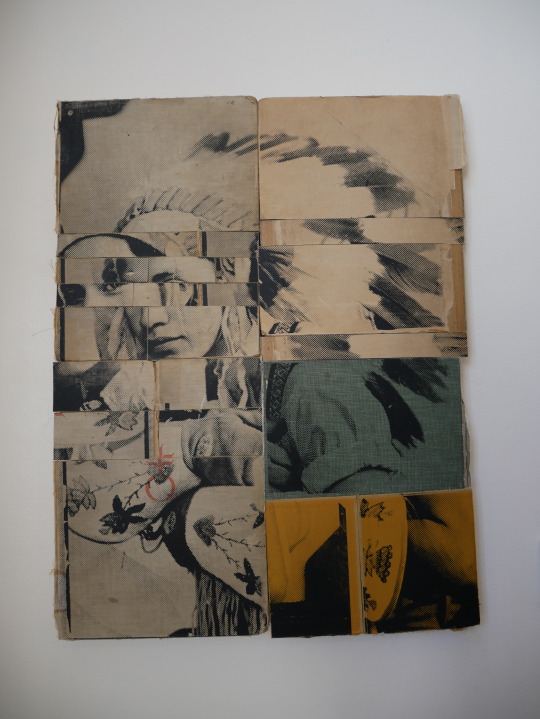
Ramone Cesspooch, Keith Secola, 2018. Silkscreen on found book covers.
The Continuous Thread Exhibition is on view until December 14th at the SFAC Main Gallery, 401 Van Ness Ave in the Veterans Building.
The Individual Portraits by Melesaine concurrently will be projected nightly from October 4-11th onto both the Asian Art Museum and SF Public Library at the location of the now removed “Early Days” statue.
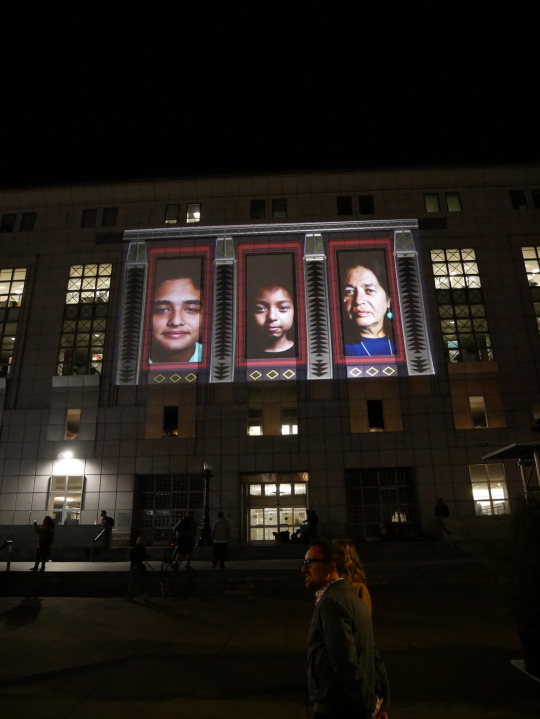
Projections on to the SFPL.
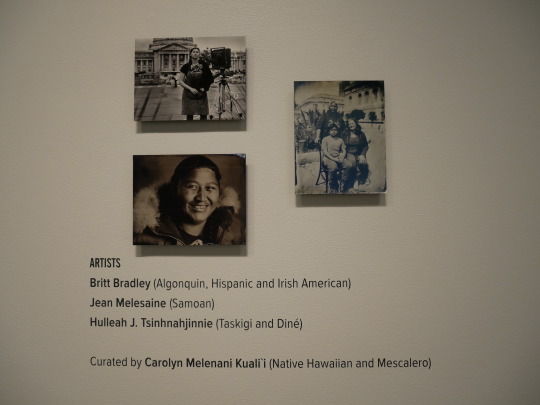
Artist’s portraits next to the entrance of SFAC Main Gallery.
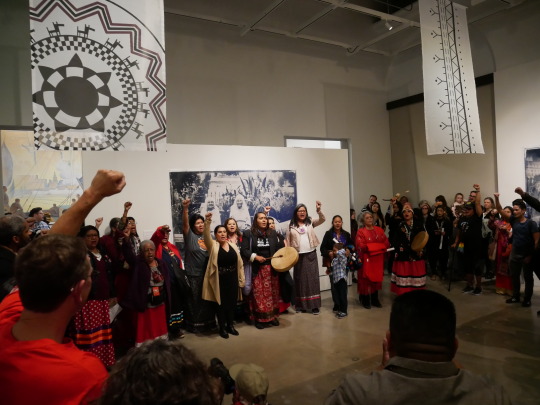
I end with a quote from the exhibit by Chief Avol Looking Horse of the Lakota, Dakota, and Nakota Nations:
“Each of us is put here in this time and this place to personally decide the future of humankind. Did you think the Creator would create unnecessary people in a time of such terrible danger? Know that you yourself are essential to this world. Understand both the blessing and the burden of that. You yourself are desperately needed to save the soul of this world. Did you think you were put here for something less? In a Sacred Hoop of Life, there is no beginning and no ending.”
---
SFAC Continuous Thread Press Release:
https://www.sfartscommission.org/experience-art/exhibitions/continuous-thread
Wahpepah’s Kitchen:
https://www.wahpepahskitchen.com/
More info on Keith Secola’s exhibit:
https://www.sfartscommission.org/experience-art/exhibitions/wounds-many-portraits-northern-ute
#jeanmelesaine#sanfranciscoartscommission#brittbradley#MelenaniKurali’l#hulleahtsinhnahjinnie#sfac#keithsecola#continuousthread
0 notes